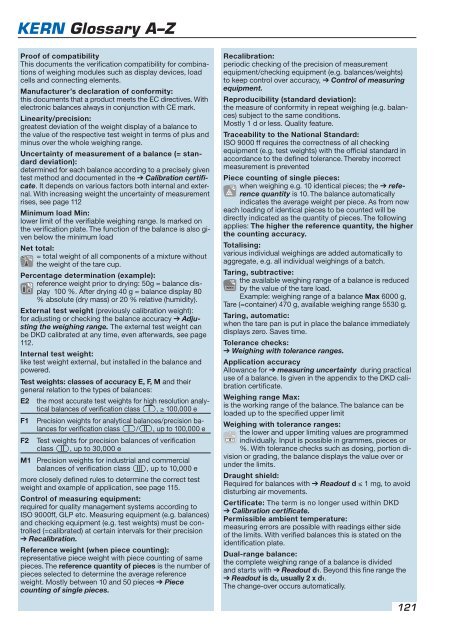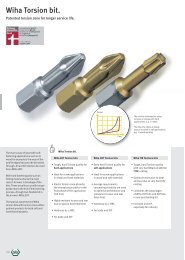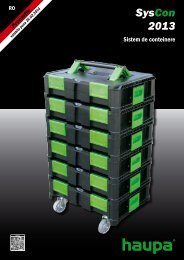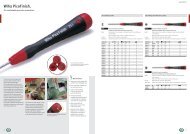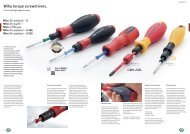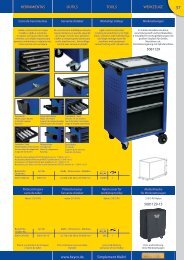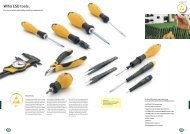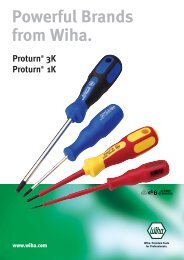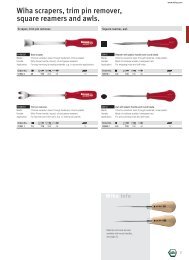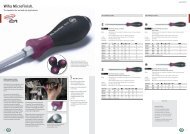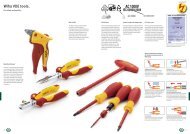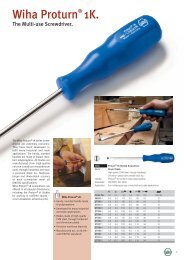Contact persons - Sesto International SRL
Contact persons - Sesto International SRL
Contact persons - Sesto International SRL
Create successful ePaper yourself
Turn your PDF publications into a flip-book with our unique Google optimized e-Paper software.
KERN Glossary A–Z<br />
Proof of compatibility<br />
This documents the verification compatibility for combinations<br />
of weighing modules such as display devices, load<br />
cells and connecting elements.<br />
Manufacturer’s declaration of conformity:<br />
this documents that a product meets the EC directives. With<br />
electronic balances always in conjunction with CE mark.<br />
Linearity/precision:<br />
greatest deviation of the weight display of a balance to<br />
the value of the respective test weight in terms of plus and<br />
minus over the whole weighing range.<br />
Uncertainty of measurement of a balance (= standard<br />
deviation):<br />
determined for each balance according to a precisely given<br />
test method and documented in the ➔ Calibration certificate.<br />
It depends on various factors both internal and external.<br />
With increasing weight the uncertainty of measurement<br />
rises, see page 112<br />
Minimum load Min:<br />
lower limit of the verifiable weighing range. Is marked on<br />
the verification plate. The function of the balance is also given<br />
below the minimum load<br />
Net total:<br />
= total weight of all components of a mixture without<br />
the weight of the tare cup.<br />
Percentage determination (example):<br />
reference weight prior to drying: 50g = balance display<br />
100 %. After drying 40 g = balance display 80<br />
% absolute (dry mass) or 20 % relative (humidity).<br />
External test weight (previously calibration weight):<br />
for adjusting or checking the balance accuracy ➔ Adjusting<br />
the weighing range. The external test weight can<br />
be DKD calibrated at any time, even afterwards, see page<br />
112.<br />
Internal test weight:<br />
like test weight external, but installed in the balance and<br />
powered.<br />
Test weights: classes of accuracy E, F, M and their<br />
general relation to the types of balances:<br />
E2 the most accurate test weights for high resolution analytical<br />
balances of verification class I , ≥ 100,000 e<br />
F1 Precision weights for analytical balances/precision balances<br />
for verification class I / II , up to 100,000 e<br />
F2 Test weights for precision balances of verification<br />
class II , up to 30,000 e<br />
M1 Precision weights for industrial and commercial<br />
balances of verification class III , up to 10,000 e<br />
more closely defined rules to determine the correct test<br />
weight and example of application, see page 115.<br />
Control of measuring equipment:<br />
required for quality management systems according to<br />
ISO 9000ff, GLP etc. Measuring equipment (e.g. balances)<br />
and checking equipment (e.g. test weights) must be controlled<br />
(=calibrated) at certain intervals for their precision<br />
➔ Recalibration.<br />
Reference weight (when piece counting):<br />
representative piece weight with piece counting of same<br />
pieces. The reference quantity of pieces is the number of<br />
pieces selected to determine the average reference<br />
weight. Mostly between 10 and 50 pieces ➔ Piece<br />
counting of single pieces.<br />
Recalibration:<br />
periodic checking of the precision of measurement<br />
equipment/checking equipment (e.g. balances/weights)<br />
to keep control over accuracy, ➔ Control of measuring<br />
equipment.<br />
Reproducibility (standard deviation):<br />
the measure of conformity in repeat weighing (e.g. balances)<br />
subject to the same conditions.<br />
Mostly 1 d or less. Quality feature.<br />
Traceability to the National Standard:<br />
ISO 9000 ff requires the correctness of all checking<br />
equipment (e.g. test weights) with the official standard in<br />
accordance to the defined tolerance. Thereby incorrect<br />
measurement is prevented<br />
Piece counting of single pieces:<br />
when weighing e.g. 10 identical pieces; the ➔ reference<br />
quantity is 10. The balance automatically<br />
indicates the average weight per piece. As from now<br />
each loading of identical pieces to be counted will be<br />
directly indicated as the quantity of pieces. The following<br />
applies: The higher the reference quantity, the higher<br />
the counting accuracy.<br />
Totalising:<br />
various individual weighings are added automatically to<br />
aggregate, e.g. all individual weighings of a batch.<br />
Taring, subtractive:<br />
the available weighing range of a balance is reduced<br />
by the value of the tare load.<br />
Example: weighing range of a balance Max 6000 g,<br />
Tare (=container) 470 g, available weighing range 5530 g.<br />
Taring, automatic:<br />
when the tare pan is put in place the balance immediately<br />
displays zero. Saves time.<br />
Tolerance checks:<br />
➔ Weighing with tolerance ranges.<br />
Application accuracy<br />
Allowance for ➔ measuring uncertainty during practical<br />
use of a balance. Is given in the appendix to the DKD calibration<br />
certificate.<br />
Weighing range Max:<br />
is the working range of the balance. The balance can be<br />
loaded up to the specified upper limit<br />
Weighing with tolerance ranges:<br />
the lower and upper limiting values are programmed<br />
individually. Input is possible in grammes, pieces or<br />
%. With tolerance checks such as dosing, portion division<br />
or grading, the balance displays the value over or<br />
under the limits.<br />
Draught shield:<br />
Required for balances with ➔ Readout d ≤ 1 mg, to avoid<br />
disturbing air movements.<br />
Certificate: The term is no longer used within DKD<br />
➔ Calibration certificate.<br />
Permissible ambient temperature:<br />
measuring errors are possible with readings either side<br />
of the limits. With verified balances this is stated on the<br />
identification plate.<br />
Dual-range balance:<br />
the complete weighing range of a balance is divided<br />
and starts with ➔ Readout d1. Beyond this fine range the<br />
➔ Readout is d2, usually 2 x d1.<br />
The change-over occurs automatically.<br />
121


